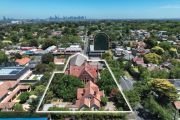
T&G building's popular brick atrium designed to feel like a relaxed outdoor space
One of the most popular features of Melbourne’s newly revitalised T&G building has nothing to do with modern technology or flashy new office furniture, it is a humble brick wall.
Made up of 14,300 patterned bricks, the wall forms an integral part of the National Trust-listed building’s atrium that was a runner-up in the 2018 Think Brick design awards.
Design firm Bates Smart was lauded for pushing the boundaries of how concrete masonry is applied in a commercial setting.
Bates Smart associate director Grant Filipoff said that prior to the renovation, which was completed last year, the atrium had been used as a thoroughfare for tenants walking to the cafe or the building’s lobbies and provided little privacy from the building’s lifts.
“We wanted to turn it into a space for tenants. We wanted to turn it into more of an outdoor space [and] the thought was that we use materials that relate to an outdoor experience,” said Mr Filipoff.
The brick wall, which consists of 2500 horizontal Austral Masonry Architec bricks and 11,800 vertical GB Split Face bricks, effectively screens the atrium from the lift bank while introducing a textured material not seen elsewhere in the building – differentiating it from public areas and creating a feeling of seclusion for tenants.
Matt Knight, head of Australia operations for building owner Pembroke, said that brick evoked feelings traditionally associated with relaxed outdoor settings.
“We wanted to create the feel of an outdoor patio [and] what outdoor patio space doesn’t have a brick barbecue?” he said.
Pembroke has now fully leased out the historic building, which it bought in 2015.
Mr Knight said that the use of brick formed an important part of the “bigger picture” of creating a warm ambience throughout the building – something which has helped attract tenants including Google and coworking group SPACES.
“It is an essential part of creating that feeling. Without the use of brick we wouldn’t have created the warm feeling that tenants are attracted to,” Mr Knight said, adding that he was often hard pushed to find a space in the atrium owing to its newfound popularity.
Mr Filipoff said that brick was becoming an increasingly popular material in the architectural world, both for residential and commercial applications, as building occupants could better connect with the material.
“It feels a lot more crafted, a lot more tactile than a lot of other materials. People can associate and related to the material because of the work that goes into laying it,” he said.
Elizabeth McIntyre, chief executive of Think Brick, said that the T&G project successfully blended heritage features with new design ideas – as recognised by its inclusion in the finalists list for the Kevin Borland Masonry Award.
“When refurbishing heritage buildings, the main focus should be on enhancing the existing form. Bates Smart demonstrated a high-calibre of craftsmanship in their invigoration of original elements of design,” she said.
Mr Filipoff said that the project had resulted in the building offering something “very different” to other commercial A-grade properties in the Collins Street area.
The T&G building, which was built in the late 1920s, was purchased by US-based Pembroke for $275 million, with the firm engaging Bates Smart in 2016 to embark on a two-year renovation.
It is one of many landmark buildings constructed in major Australian cities and towns by the former T & G Mutual Life Assurance Society, many of which featured the same distinctive stepped top as the Melbourne property, which is located on the corner of Russell and Collins streets.
Entries close for the 2019 Think Brick Awards on May 3, with the winners announced in August.













